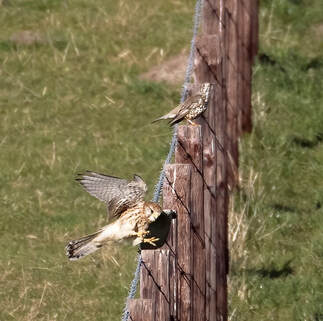 Mistle thrush (turdus viscivorus) Alun Williams333, CC BY-SA 4.0 httpscreativecommons.orglicensesby-sa4.0, via Wikimedia Commons Mistle thrush (turdus viscivorus) Alun Williams333, CC BY-SA 4.0 httpscreativecommons.orglicensesby-sa4.0, via Wikimedia Commons In February's Focus, Andrew Graham homes in on one of our native birds, the mistle thrush: 'As the winter days lengthen, anticipating the breeding season, birds start to sing again. Echoing through countryside and woodland, the song of the male mistle thrush is melodious and distinctive. While the tone resembles that of the blackbird or song thrush, its repertoire is less varied with a slower delivery. However, compared to its relatives, the mistle thrush's song is much louder, often audible up to 2 km away. The song is given from a treetop or other elevated position mainly from November to early June. The male is most vocal in the early morning, and its tendency to sing after, and sometimes during, wet and windy weather led to the old name - stormcock. 'Its commoner name is probably derived from its love of mistletoe berries, on which it feeds voraciously given the chance: its scientific name, Turdus viscivorus, means mistletoe-eating thrush. In turn, it helps the mistletoe - a parasitic plant that grows on tree bark fissures - by unintentionally “sowing” seeds when wiping its bill on tree bark to remove the berries’ sticky residue or by excreting seeds onto the limbs of the parasitised tree as it feeds. This might explain why trees with mistletoe are often so smothered in the stuff. The more it grows, the more seeds get deposited on the bark by feeding birds.' On that basis, there's a tree in Dinton on the left hand side of the road going towards Salisbury which it would be well worth staking out as it's covered in mistletoe - and it's great to know how this might have come about.  Abby Eaton took this lovely photo of one in a tree on the corner of Hillground Copse, the woodland just SSW of Fonthill Lake, so well worth watching out round there. The nearest footpath runs up from the river over Lady Down to Ridge/the Lake so take your binoculars.  But she also caught the close encounter with a kestrel down near Messums! Abby says that 'they hate having anything else in 'their' tree. They shrieked at the redwings, blackbirds and other small flock birds who had the audacity to land on any of their branches. Relentless squawking the whole time I was there. I left them to it.' This must be what the BTO terms 'resource guarding', which is 'when one or sometimes two birds defend a food source, such as a holly or yew. This is defended against all-comers, the vigilant bird trying to ensure that food resources are maintained for itself throughout the winter. It has been shown that resource guarding birds have bigger and earlier clutches than birds that do not do it.' Andrew continues: 'The largest thrush species in the UK, the mistle thrush measures around 28cm in length. It has greyish-brown upperparts, a long tail, and a plump white belly with heavy, dark brown spots. Its legs are yellow brown in colour, and it is an altogether stockier and more grey-looking bird than the song thrush. Male and female have the same plumage. In contrast to the song thrush, it is more likely to be seen feeding out in the open, hopping with its body erect and head held high, then standing upright and bold. In flight, it usually flies at tree top height with several wing beats separated by short glides. 'The underside of the wings is white. This helps to distinguish it from the smaller redwing and song thrush which have red and buff underwings, respectively. The fieldfare which is slightly smaller than the mistle thrush has a quite different “chack chack” call, a less undulating flight and is only seen hereabouts in winter.
'As well as mistletoe berries, this thrush eats other berries, seeds, and fruit, as well as worms and insects. It is fiercely territorial when it comes to food and will vigorously defend the holly bush or yew tree on which is feeding. Its warning call is a sharp chattering noise which sounds most like a wooden football rattle (if anyone still uses these?). 'Mistle thrushes usually breed from February to May, with the female building a big, messy, grass-lined nest in the fork of a tree.' (Go to this link on Wikimedia Commons, from which many of our photos are sourced, for an amazing video of a nest with adults feeding young, and the young fledging. Bear with the orchestral prelude, the birdsong begins at about 40secs!) The chaffinch often nests close to a mistle thrush, the vigilance of the chaffinch and the aggressive behaviour of the thrush benefiting both species. 'Unfortunately, mistle thrush populations in the UK have been in decline since the 1970s especially in farmland areas. But they are widespread across the UK and rarely migrate. They are absent from some Scottish isles and areas of extremely high, bare ground.' Comments are closed.
|
Photo: Avocets (Izzy Fry)
The headers display photos taken by our members. Do get in touch via the Contact Form if you'd like to submit a photo for selection.
Archives
May 2024
Categories
All
|

 RSS Feed
RSS Feed